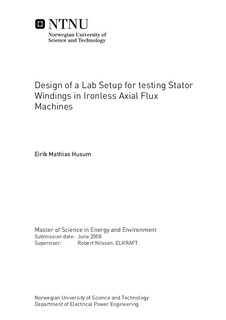Design of a Lab Setup for testing Stator Windings in Ironless Axial Flux Machines
Master thesis
Permanent lenke
http://hdl.handle.net/11250/257444Utgivelsesdato
2008Metadata
Vis full innførselSamlinger
- Institutt for elkraftteknikk [2465]
Sammendrag
Axial flux machines may give higher power-to weight ratios than conventional radial flux machines. As the axial flux machine can easily be constructed with a multi-rotor configuration, it is well suited for ironless stator design, which has gained interest in the latest years due to the development of high remanent flux density permanent magnets. In addition to the reduced eddy current losses and weight of the stator itself, an ironless design eliminates the magnetic forces acting on the stator, so that the necessity of a heavy stator frame is reduced.Several winding topologies exist for ironless stators, and it can be interesting to compare these with each other. For this purpose, an ironless axial flux 110 pole dual rotor permanent magnet machine with easily exchangeable stator has been made. This machine allows preliminary tests on different stator designs before more expensive prototypes are built. As all active parts of the machine are visible, it may also serve as a demonstration model for electro-mechanical energy conversion.Simulations done on a single-layer 3-level-endturn winding with q=6/5 shows an induced voltage of 40.22 V at 50 Hz. This corresponds well with measurements done on a stator segment covering 2/11 of the machine. The measured DC resistance of this segment is equivalent of 2.51Ω for a complete stator, which even though somewhat less than calculated, is rather large due to long endturns compared to the radial length of the conductors. The measured inductance of the segment equals self and mutual inductances of about 0.55 μH and 0.275 μH for a complete stator, which is significantly less than calculated.
